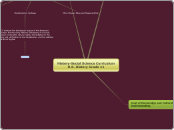door Nikole Burgess 12 jaren geleden
681
History-Social Science Curriculum

door Nikole Burgess 12 jaren geleden
681

Meer zoals dit
11.10.2. Examine and analyze the key events, policies, and court cases in the evolution of civil rights, including Dred Scott v. Sandford, Plessy v. Ferguson, Brown v. Board of Education, Regents of the University of California v. Bakke, and California Proposition 209.
11.1.1. Describe the Enlightenment and the rise of democratic ideas as the context in which the nation was founded.
11.11.3. Describe the changing roles of women in society as reflected in the entry of more women into the labor force and the changing family structure.
11.11.6. Analyze the persistence of poverty and how different analyses of this issue influence welfare reform, health insurance reform, and other social policies.
CCSS.ELA-Literacy.RH.11-12.3 Evaluate various explanations for actions or events and determine which explanation best accords with textual evidence, acknowledging where the text leaves matters uncertain.
CCSS.ELA-Literacy.RH.11-12.9 Integrate information from diverse sources, both primary and secondary, into a coherent understanding of an idea or event, noting discrepancies among sources.
CCSS.ELA-Literacy.WHST.11-12.2b Develop the topic thoroughly by selecting the most significant and relevant facts, extended definitions, concrete details, quotations, or other information and examples appropriate to the audience’s knowledge of the topic.
CCSS.ELA-Literacy.WHST.11-12.2d Use precise language, domain-specific vocabulary and techniques such as metaphor, simile, and analogy to manage the complexity of the topic; convey a knowledgeable stance in a style that responds to the discipline and context as well as to the expertise of likely readers.
CCSS.ELA-Literacy.SL.11-12.1b Work with peers to promote civil, democratic discussions and decision-making, set clear goals and deadlines, and establish individual roles as needed
CCSS.ELA-Literacy.SL.11-12.4 Present information, findings, and supporting evidence, conveying a clear and distinct perspective, such that listeners can follow the line of reasoning, alternative or opposing perspectives are addressed, and the organization, development, substance, and style are appropriate to purpose, audience, and a range of formal and informal tasks.
11.11.2. Discuss the significant domestic policy speeches of Truman, Eisenhower, Kennedy, Johnson, Nixon, Carter, Reagan, Bush, and Clinton (e.g., education, civil rights, economic policy, environmental policy).
11.10.1. Explain how demands of African Americans helped produce a stimulus for civil rights, including President Roosevelt's ban on racial discrimination in defense industries in 1941, and how African Americans' service in World War II produced a stimulus for President Truman's decision to end segregation in the armed forces in 1948.
A major accomplishment of medical science since the end of World War II has been the virtual worldwide elimination of death caused by A malaria. B smallpox. C cholera. D tuberculosis.
11.6.2. Understand the principal explanations of the causes of the Great Depression and steps taken by the Federal Reserve, Congress and Presidents Herbert Hoover and Franklin Delano Roosevelt to combat the economic crisis.
11.5.7. Discuss the rise of mass production techniques, the growth of cities, the impact of new technologies (e.g., the automobile, electricity), and the resulting prosperity and effect on the American landscape.
Many business groups opposed the Tennessee Valley Authority (TVA) in the 1930s on the grounds that it A unfairly competed with private power companies. B charged too much for the electricity it sold. C did not treat its electric customers equally. D generated electricity with obsolete methods and equipment.
11.2.2 Describe the changing landscape, including the growth of cities linked by industry and trade, and the development of cities divided according to race, ethnicity, and class.
11.7.2 Explain U.S. and Allied wartime strategy, including the major battles of Midway, Normandy, Iwo Jima, Okinawa, and the Battle of the Bulge.
The United States supported a revolution in Panama at the turn of the 20th century in order to A stop human rights abuses in Latin American countries. B prevent the spread of communism in Latin America. C secure the right to build a canal through Central America. D end European colonialism in Central America.
11.3.4 Discuss the expanding religious pluralism in the United States and California that resulted from large-scale immigration in the twentieth century.
11.5.2 Analyze the international and domestic events, interests, and philosophies that prompted attacks on civil liberties, including the Palmer Raids, Marcus Garvey’s “back-to-Africa” movement, the Ku Klux Klan, and immigration quotas and the responses of organizations such as the American Civil Liberties Union, the National Association for the Advancement of Colored People, and the Anti-Defamation League to those attacks.
The primary religious issue of the 1960 presidential election in the United States was A the Catholic faith of John F. Kennedy. B Richard Nixon’s upbringing as a Quaker. C the teaching of creationism in public schools. D the Mormonism of George Romney.
11.11.1 Discuss the reasons for the nation’s changing immigration policy, with emphasis on how the Immigration Act of 1965 and successor acts have transformed American society.
11.10.2. Examine and analyze the key events, policies and court cases in the evolution of civil rights, including Dred Scott v. Sandford, Plessy v. Ferguson, Brown v. Board of Education, Regents of the University of California v. Bakke, and California Proposition 209.
What effect did the African-American civil rights movement have on other minority groups in the United States? A It brought about anti-discrimination legislation that applied to other groups. B The backlash caused other minority groups to limit the use of civil disobedience. C It convinced other groups to create one unified civil rights movement. D It convinced other groups to minimize the use of protests as a way to end discrimination.
11.1.1 Describe the Enlightenment and the rise of democratic ideas as the context in which the nation was founded.
11.3.3. Cite incidences of religious intolerance in the United States (e.g., persecution of Mormons, anti-Catholic sentiment, anti-Semitism).
Key decisions of the Supreme Court under the leadership of John Marshall solidified the power of the Supreme Court to A try cases between states. B accept appeals from lower federal courts. C try cases involving foreign diplomats. D review the constitutionality of state and federal laws.